
Lepidoptera or lepidopterans is an order of winged insects that includes butterflies and moths. About 180,000 species of the Lepidoptera have been described, representing 10% of the total described species of living organisms, making it the second largest insect order with 126 families and 46 superfamilies, and one of the most widespread and widely recognizable insect orders in the world.

Moths are a group of insects that includes all members of the order Lepidoptera that are not butterflies. They were previously classified as suborder Heterocera, but the group is paraphyletic with respect to butterflies and neither subordinate taxon is used in modern classifications. Moths make up the vast majority of the order. There are approximately 160,000 species of moth, many of which have yet to be described. Most species of moth are nocturnal, although there are also crepuscular and diurnal species.

The luna moth, also called the American moon moth, is a Nearctic moth in the family Saturniidae, subfamily Saturniinae, a group commonly named the giant silk moths.

The cinnabar moth is a brightly coloured arctiid moth found as a native species in Europe and western and central Asia then east across the Palearctic to Siberia to China. It has been introduced into New Zealand, Australia and North America to control ragwort, on which its larvae feed. The moth is named after the red mineral cinnabar because of the red patches on its predominantly black wings. The species was first described by Carl Linnaeus in his 1758 10th edition of Systema Naturae. Cinnabar moths are about 20 mm (0.79 in) long and have a wingspan of 32–42 mm (1.3–1.7 in).

Gracillariidae is an important family of insects in the order Lepidoptera and the principal family of leaf miners that includes several economic, horticultural or recently invasive pest species such as the horse-chestnut leaf miner, Cameraria ohridella.
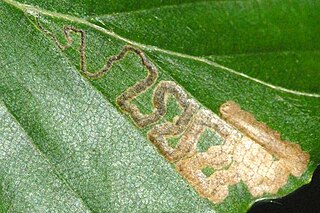
Stigmella tityrella is a moth of the family Nepticulidae. It is found in all of Europe, except the European part of Russia.
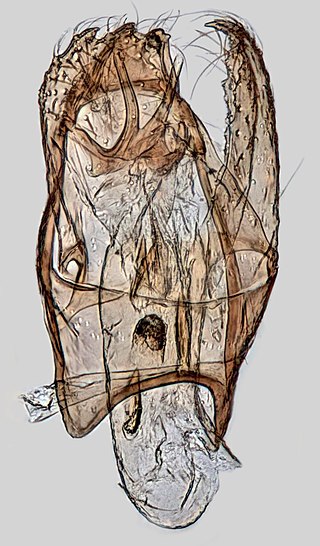
Stigmella obliquella is a moth of the family Nepticulidae which feeds on willow and can be found in Asia and Europe. It was first described by Hermann von Heinemann in 1862.
Stigmella aladina is a moth of the family Nepticulidae. It is found in Russia, China (Heilongjiang) and Japan.
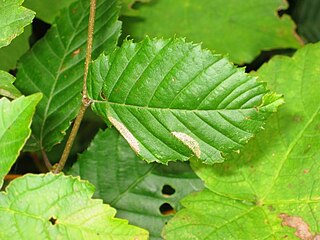
Phyllonorycter tenerella is a moth of the family Gracillariidae. It is found from Sweden to the Pyrenees, Italy and Bulgaria and from Great Britain to north-western Russia and Ukraine.

Phyllonorycter stettinensis is a moth of the family Gracillariidae. It is found from Scandinavia and Finland to the Pyrenees, Corsica, Italy and Bulgaria and from Great Britain to Russia.

Phyllonorycter dubitella is a moth of the family Gracillariidae. It is found from Fennoscandia and northern Russia to the Pyrenees, Italy and Bulgaria and from Great Britain to Ukraine.
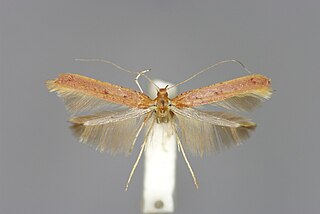
Caloptilia elongella is a moth of the family Gracillariidae. It is known from all of Europe east to eastern Russia. It is also found in North America from British Columbia, south to California and east in the north to New Hampshire and New York.
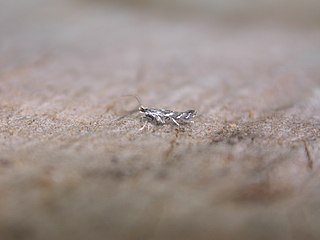
Leucospilapteryx omissella is a moth of the family Gracillariidae. It is known from all of Europe, east through Russia to Japan.
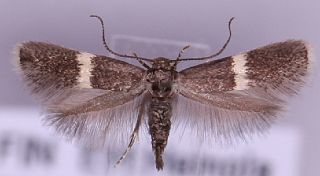
Elachista cingillella is a moth of the family Elachistidae found in Europe.

Elachista bedellella is a moth of the family Elachistidae found in Europe.

Mompha sturnipennella is a moth in the family Momphidae. It is found in the Holarctic ecozone and is found in most of Europe, Siberia, the Russian Far East and Canada.

Cydalima perspectalis or the box tree moth is a species of moth of the family Crambidae, first described by Francis Walker, the English entomologist, in 1859. Native to Japan, China, Taiwan, Korea, far-east Russia and India, it has invaded Europe; first recorded in Germany in 2006, then Switzerland and the Netherlands in 2007, Great Britain in 2008, France and Austria in 2009, Hungary in 2011, then Romania, and Spain. It has been seen in Slovakia, Belgium and Croatia.

Digitivalva valeriella is a moth of the family Acrolepiidae. It is found in Sweden, Denmark, Germany, France, Austria, Hungary, Romania, Slovakia, Poland, Lithuania, Latvia and Russia.

Bucculatrix noltei is a moth in the family Bucculatricidae. It is found from Finland to Belgium, Italy and the Crimea and from the Netherlands to Central Russia. It was described by August Arthur Petry in 1912.
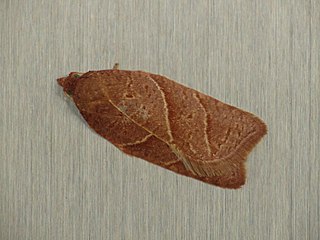
Acleris platynotana is a species of moth of the family Tortricidae. It is found in China, Japan and the Russian Far East. The habitat consists of rhododendron groves and black birch-oak-pine forests.



















